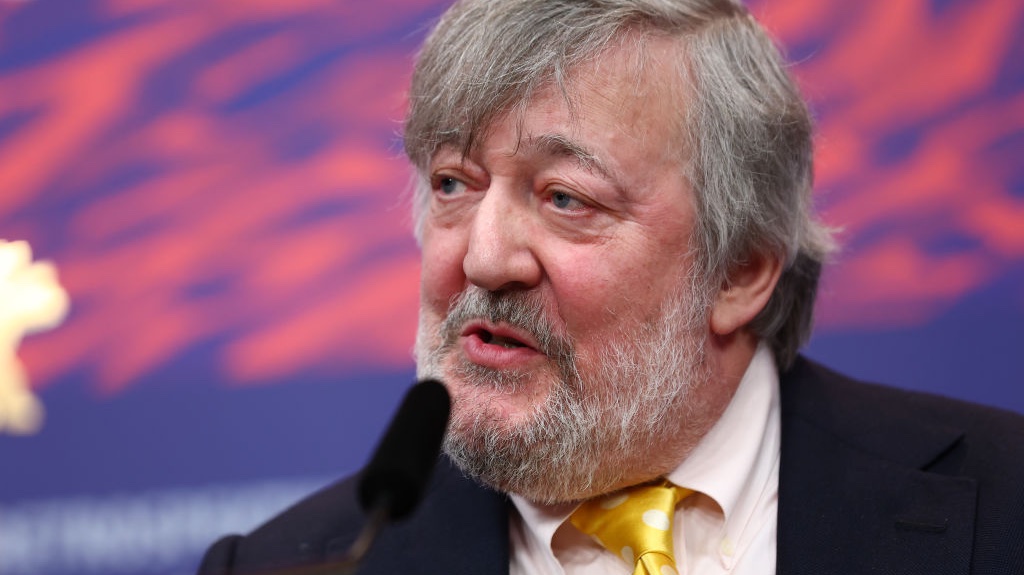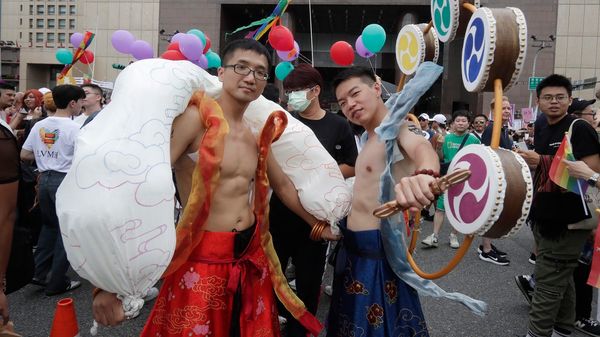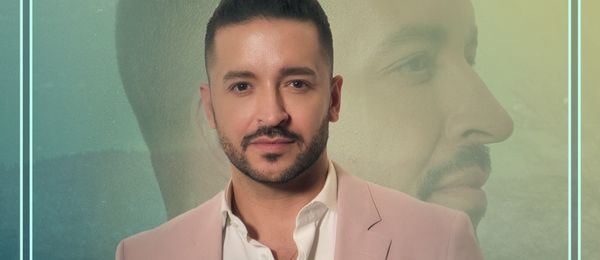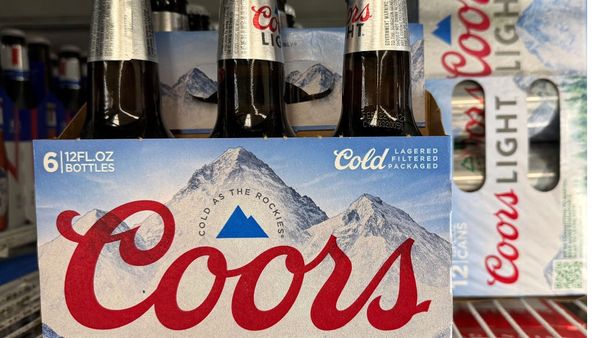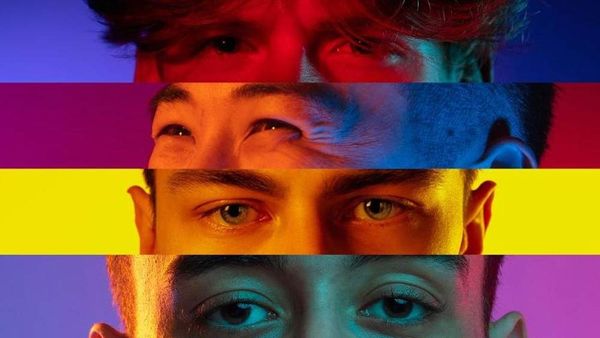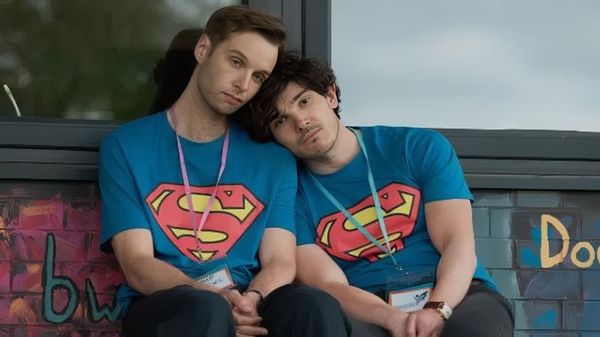
June 18, 2017
SFO Exhibit Will Honor Pride Flag Creator
Matthew S. Bajko READ TIME: 4 MIN.
Sometime in the late 1990s Gilbert Baker, the creator of the iconic rainbow flag, began dreaming up an idea to install an exhibit at the San Francisco International Airport, which has its own museum and mounts various art exhibits in its four terminals. It would incorporate American flags he had created for the 1984 Democratic Convention that decorated the ceiling of the Moscone Center in downtown San Francisco.
In September 2001 Baker and his close friend, Cleve Jones, had scheduled a meeting with the airport's then-deputy director, Peter Nardoza, a gay man who had been a mayoral aide to Dianne Feinstein. (He died in 2011.) But it came just days after the horrific events of September 11, when terrorists hijacked four airplanes, flying two into the World Trade Center in New York City and one into the Pentagon outside Washington, D.C. The fourth crashed in a field in Pennsylvania due to the actions of the passengers, including gay San Francisco rugby player Mark Bingham.
"It was so eerie walking through the terminals. It was completely empty," recalled Jones. "My best recollection was he had this idea of having the flags suspended from the ceiling at the airport."
The U.S. flags had wires sewn into them so they could be manipulated into various shapes. But due to new security measures instituted at airports across the country following 9/11, Baker's plans for the airport installation were shelved.
Earlier this year, he returned to the idea. This time Baker was conceiving an exhibit on the history of the Pride flag to coincide with the 40th anniversary in 2018 of his having created the global LGBT symbol.
"Gilbert always wanted to have a show at the airport," gay District 8 Supervisor Jeff Sheehy, a close friend of Baker's, told the Bay Area Reporter. "I was talking to Gilbert about it and he wanted rainbow flag banners hung around SFO."
Sadly, Baker unexpectedly died March 31 at his home in New York. He was 65. His death was caused by hypertensive and atherosclerotic cardiovascular disease, according to the New York City medical examiner's office.
With Baker's sudden passing, his friends and city officials are now working to make his vision for an SFO exhibit a reality next year.
"I think it is possible to do something wonderful at the airport for the 40th anniversary of the rainbow flag. Who knows, maybe it is fabric, maybe it is projection of images," said Jones, speaking by phone from New York this week where he was to attend a memorial march in honor of Baker. "I think all sorts of things could be done, especially if done with projections and lights."
A frequent flyer through SFO, Jones said he is always impressed by the quality and diversity of the art exhibits mounted by the airport museum staff.
"I think the curators of the art spaces in the airport do a tremendous job. I am always struck by the beautiful curating that goes on there," said Jones.
The preliminary discussions about an exhibit have focused on a budget and where at the airport to mount the show, the B.A.R. has learned. It is unclear whether it would be in just one terminal or more and if portions could be displayed in pre-security areas so even those without booked flights could view it.
"The exhibit is currently in the conceptual stage; airport, arts commission, and representatives from Supervisor Sheehy's office are in ongoing discussions about the scope and timing of the exhibit at SFO," airport spokesman Doug Yakel confirmed in an emailed reply to the B.A.R.
Sheehy told the B.A.R. the hope is that the exhibit could be installed by June next year to coincide with Pride Month, four decades after the debut of the Pride flag. Gilbert created the first rainbow flags, which initially had eight colored bars, in time to display them on flagpoles in United Nations Plaza, a few blocks from San Francisco City Hall, for the 1978 Gay Freedom Day Parade.
Celebration of Life
"I am a total fabric queen, that is my craft," said Baker in a video shown during a celebration of his life at the Castro Theatre Thursday, June 8. "The pink triangle was put on us by the Nazis. We needed our own symbol."
His idea for using a flag was sparked by the hoopla surrounding the United States Bicentennial in 1976. class=st> As Gilbert recalled in the video, the American flag that year was not only flown on countless buildings but was also emblazoned on all manner of products, from clothing to furnishings.
"I saw the American flag everywhere," said Baker, adding that the flag's ubiquity made him realize how powerful of a symbol it could be.
On the last rainbow flag banner Baker made for Jones, he affixed the slogan "Rise and Resist" on it. When Jones had two Sisters of the Perpetual Indulgence unfurl it last Thursday on the theater's stage, it brought the crowd of more than 600 people to its feet.
"He thought outside of the box always. He was a true artist," said Dr. Jerome Goldstein, adorned in a rainbow hat, jacket, and shirt.
Goldstein and his husband, Tom Taylor, were longtime friends with Baker and considered him a part of their family. Through their Diversity Foundation, which oversees the gigantic rainbow flag and flagpole Baker installed in the Castro, the couple coordinated last week's service.
In another video segment shown during the ceremony, Taylor explained Baker dropped two of the original colors from the flag so they could be commercially produced. The first two flags, one of which resembled an American flag with stars, were created by hand. Baker and friends dyed the fabric themselves at the LGBT Community Center that had been on Grove Street in the 1970s.
Baker never trademarked the rainbow flag and didn't benefit financially from its adoption by the LGBT community the world over.
"There was a commitment on his part to leaving the world a better place," said Goldstein, adding that, "The rainbow flag is forever."
